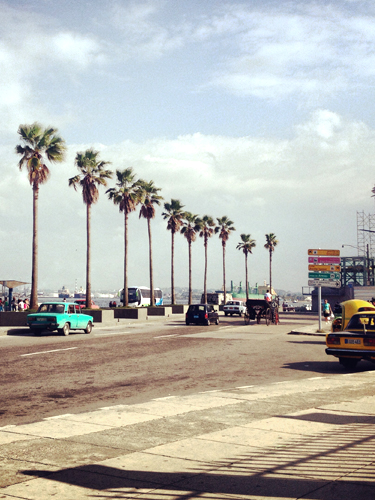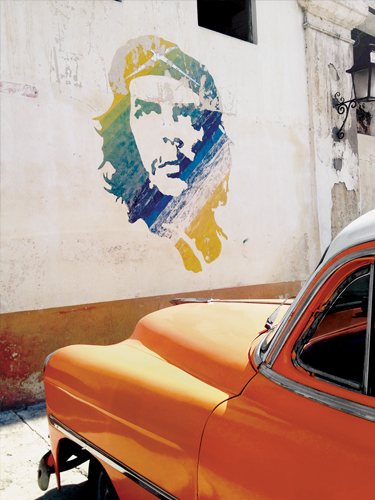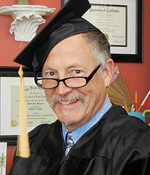Destination: Cuba
[rev_slider Cuba]
Talks between Cuban and US leaders to normalize relations between the two countries have people stateside thinking about travel to Cuba without restrictions or hassles. While we await the green light, Insights asked Professor Swift Dickison what the American experience is like in Cuba now. Dickison and a group of 27 students, faculty, and MC friends traveled to Cuba in 2014, as part of Professor Greg Malveaux’s Travel Abroad program. It was Dickison’s second trip to Cuba. In 2011, he attended the Caribbean Literature Conference there. Even then, there was the imminent sense that dramatic change was coming for Cuba.
“I knew that [we] would need to visit,” says Dickison, “in spite of the challenges of doing so.”
Since the 1960 US embargo against Cuba, known there as el bloqueo, “the blockade,” the Treasury Department’s Office of Foreign Assets Control (OFAC) established travel regulations that are still enforced. The regulations allow 12 types of travel to Cuba, which include official government business, family visitation, educational and humanitarian excursions, cultural performances, and athletic events, among others. Tourism is not among the sanctioned reasons to visit. Spending money there without a license is also not allowed, so US visitors pay for everything with cash.
In addition to no credit cards, Dickison also advised the MC travelers to prepare for limited Internet access and nonexistent cell phone service. Also, each of them would be required to pay a $35 departure tax in order to return home with the group.
 On January 7, they flew from Dulles Airport to Miami, where they toured the Bay of Pigs Museum in Little Havana before the flight to Cuba. During the bus ride to the Bay of Pigs Museum in Little Havana, the group glimpsed blue skies and palm trees, harbingers of their destination. The tour guide pointed out a huge tree with massive roots enshrined with Santeria offerings of chicken corpses and scattered objects.
On January 7, they flew from Dulles Airport to Miami, where they toured the Bay of Pigs Museum in Little Havana before the flight to Cuba. During the bus ride to the Bay of Pigs Museum in Little Havana, the group glimpsed blue skies and palm trees, harbingers of their destination. The tour guide pointed out a huge tree with massive roots enshrined with Santeria offerings of chicken corpses and scattered objects.
Inside the museum, Pepe recited facts about the Revolution and the failed attempt to overthrow the young Castro regime. His version was replete with “martyrs,” those who sacrificed themselves in the fight, and “gusanos,” or worms, the term used to describe Cubans who opposed Castro.
“We realized,” says Dickison, “we were about to embark on a complex journey of discovery and critical thinking.”
On to Cuba. Adriana and Jorge, their two tour guides greeted them at the airport. The OFAC mandates US groups be accompanied by two guides. At least one guide must speak English and Spanish, and at least one must be non-Cuban.
“Jorge used great discretion,” says Dickison, “never contradicting Adriana… but he did provide an alternate perspective if the group seemed to be succumbing to a ‘rose-colored spectacles’ version of the Cuban Revolution and its aftermath.” Jorge was Peruvian; Adriana was Cuban. The group was also passively “protected” from pro-Castro/pro-Revolution propaganda by anonymous government “minders,” agents who monitor tour presentations.
At Havana University, for example, the group suspected a nonchalant man in casual clothes who joined their group. And they certainly noticed city buses plastered with English messaging that called for the US to end its blockade against the Cuban people. And they heard nothing but good things about post-Revolution improvements in Cuban health care, education, diet, and innovation.
Rhetoric aside, the lack of commercial goods and simple comforts were striking.
In restaurants, servers brought the “Yankees” heaping platters of foods that are denied to Cuban citizens. The MC group enjoyed savory chicken and pork dishes, seafood, paella, black bean soup, fried chick peas, rice pudding, and fresh vegetables from heaping platters, while local families worked to stretch meagre portions of rationed rice and beans amongst themselves.
 Music and the arts are thriving in Cuba. Dickison’s group acclimated quickly to the inconic rhythms of guitar, conga, and clave that enliven street corners, restaurants, and clubs. One evening, they watched a performance of the Buena Vista Social Club. The large Latin jazz ensemble, originally formed with guitarist Ry Cooder, played percussion and brass without a break for nearly three hours—what Dickison calls a marathon of songs.
Music and the arts are thriving in Cuba. Dickison’s group acclimated quickly to the inconic rhythms of guitar, conga, and clave that enliven street corners, restaurants, and clubs. One evening, they watched a performance of the Buena Vista Social Club. The large Latin jazz ensemble, originally formed with guitarist Ry Cooder, played percussion and brass without a break for nearly three hours—what Dickison calls a marathon of songs.
“What was notable, besides the superb Cuban jazz, was the tag-team flow of individual vocalists, mostly males, and most in their 80s. In their guaybera shirts and Panama hats,” he says, “they made their way to the microphone to deliver traditional songs at the front of the band, then returned to a table at the rear of the restaurant to sit and rest by turns.”
In addition to minders and special treatment for visitors, the MC group noticed something else: they were segregated from the European visitors—mostly British, German, and Dutch—as much as possible. At their hotels and other lodgings, they were among other small “American” groups. Dickison felt it was an attempt by Cuban hosts to maintain a positive experience for all their visitors. In other words, not everyone likes the idea of Americans in Cuba, mainly because they expect the US to encroach on the island’s culture by bringing in the ubiquitous fast-food and retail chain stores if and when US-Cuban relations become fully normalized.
More than once, Dickison heard Cubans assured them they harbored no animosity toward the American people, just the US government’s “blockade.”
The group’s last night on the island held an unexpected surprise. They attended a special meeting with a local branch of the Committee for the Defense of the Revolution (CDR), the largest non-governmental organization in Cuba. The travel itinerary read: “a meeting with local CDR, a Cuban neighborhood organization for ‘people to people’ interaction with the multi-generational families that make up any given Cuban neighborhood.”
After an enthusiastic greeting, and impromptu speeches from CDR men, women, and children who passed a microphone and “pronounced particulars” of the organization, the evening’s tone intensified when a small group lined up and stood in solidarity with “the Cuban Five.” The “five” are Cuban intelligence officers imprisoned in Miami for infiltrating Cuban exile counterrevolutionary groups in South Florida. The US Supreme Court has declined to hear the case.
“The five young neighbors raised clenched fists,” says Dickison, “as the plight of the prisoners was broadcast in solemn tones from the microphone.” But cake and punch, music and dancing lifted their spirits almost immediately. Dickison says the room exploded with energy.
During the festivities, children in their Sunday best and young men wearing their only suits and tattered ties approached politely to shake hands and inquire: Mi amigo?” One man invited Dickison into his home, a cement shack with bare but spotless floors.
The Travel Abroad group returned home with their souvenirs, photographs, and journal entries (thank you, Professor Dickison), but they count the evening with the CDR as one of their most treasured takeaways: they recall the smiles, the handshakes, the dancing, and the goodwill. They hope to find this amity unchanged when they return, whatever else may change.
—Diane Bosser
[rev_slider Cuba2]
 Swift Stiles Dickison holds a BA in English, an MA in creative writing, and a PhD in Caribbean literature. He has lived in Damascus, Syria; St. Thomas, US Virgin Island, Guadalajara, Mexico, and Northern California. He has traveled and worked in the Caribbean, Europe, China, Australia, and New Zealand. A professor in the Department of English at Montgomery College’s Rockville Campus since 2001, he has taught World Literature, Creative Writing, Caribbean Literature, Postcolonial Literature, American Literature, Modern Poetry, Women Studies, and Composition. Besides teaching, Dr. Dickison writes fiction and poetry, and plays percussion and guitar with the Montgomery College World Ensemble.
Swift Stiles Dickison holds a BA in English, an MA in creative writing, and a PhD in Caribbean literature. He has lived in Damascus, Syria; St. Thomas, US Virgin Island, Guadalajara, Mexico, and Northern California. He has traveled and worked in the Caribbean, Europe, China, Australia, and New Zealand. A professor in the Department of English at Montgomery College’s Rockville Campus since 2001, he has taught World Literature, Creative Writing, Caribbean Literature, Postcolonial Literature, American Literature, Modern Poetry, Women Studies, and Composition. Besides teaching, Dr. Dickison writes fiction and poetry, and plays percussion and guitar with the Montgomery College World Ensemble.
Cuba: BEFORE YOU GO
Professor Dickison’s Suggested Reading
Books
- The Cuba Reader: History, Culture, Politics
Eds Aviva Chomsky, Barry Carr, and Pamela Maria Smorkaloff. Durham and London, Duke U.P., 2003 - Contemporary Caribbean Cultures and Societies in a Global Context
Eds Franklin W. Knight and Teresita Martinez-Vergne. 2005. - Cuba: A Guide to the People, Politics, and Culture Hatchwell, Emily and Simon Calder. New York: Interlink Books, 2000.
- The Economic War Against Cuba: A Historical and Legal Perspective on the U.S. Blockade. By Salim Lamrani. New York: Monthly Review P., 2011
Topics
- The Malecon and historic Havana neighborhoods
- The Belen Convent (or any aspect of religion in Cuba)
- The Revolution
- Environmental Issues and Sustainability
- The Paladar
- Cuban art
- Political issues between the US and Cuba
- Children’s theatre in Cuba
- Slavery in Cuba
- Los Munequitos de Matanzas
- Hemingway in Cuba



Interesting and well-balanced article. Glad to see MC students experiencing Cuba as it is… without cell phones or social media, seeing obvious apartheid first hand, sensing the I’m-not-free-to-roam atmosphere, as well as the music and the warmth of the Cuban people.
Now I would implore the professor to explore Cuba prior to the revolution… Cuba as a young emerging country. (YouTube can actually serve as one of many sources.) The contrast is astounding. There were no collapsing buildings, the dollar and the peso were worth pretty much the same (actually, the peso in the 50’s was worth more), QUALITY health care was free to all… including surgeries and any needed medications (Cuba’s infant mortality rate in 1953 was HALF that of the US), and education was free through post graduate work… yes, including medical school. My Dad is a retired oral surgeon. He paid only for room and board while attending the University of Havana. Were there problems and social issues? Obviously. I was raised in an imperfect paradise… with a revolution brewing in the background. But, what I see in photographs today crushes my heart. It is a colossal failure of a state and society. It bears no resemblance to the Cuba I knew… and, frankly, I’m in no rush to experience it.
Having recently returned from a three week vacation in China where my husband I traveled solo all over the country and were free to go anywhere we pleased… with mere traces of state control… I look forward to the day when that is possible in Cuba. It will signal the end of the regime as we now know it. And, that is a very good thing.
Hortensia (Tensi) Torres-Comas
Class of ’69